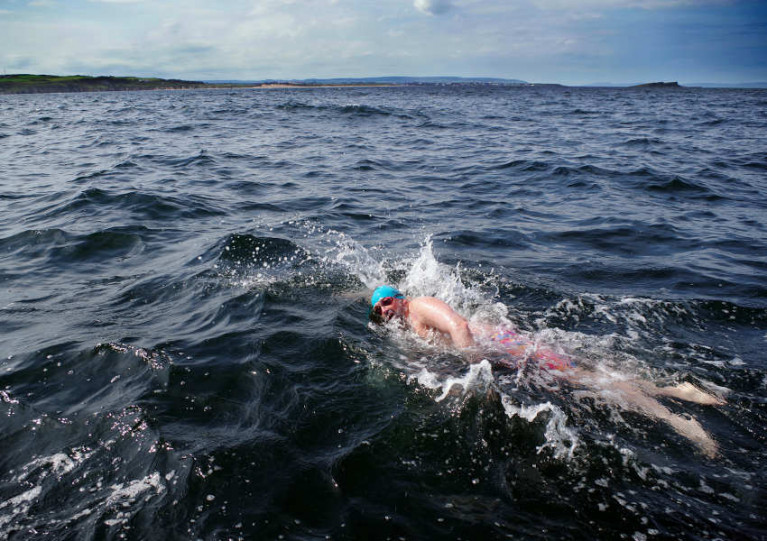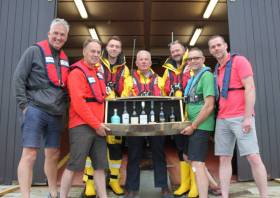Displaying items by tag: Islay
Northern Ireland Swimmers First To Cross Challenging Sea Route From Scotland To Giant’s Causeway
Members of an open sea swimming team have become the first to complete a challenging route between Scotland and the Giant’s Causeway, as the Greenock Telegraph reports.
The Oa Giants set out from Islay last Saturday 8 August and crossed the Oa Channel by relay, reaching Northern Ireland’s North Coast on Sunday 9 August with a final time of 16 hours and 57 minutes.
Comprising Keith Garry, Dominic Mudge, Bill Donnelly, Chris Judge, Colin Lindsay and John McElroy, the team were already record-breakers heading into their challenge.
That was after setting a time of nine hours, two minutes and 41 seconds across the North Channel between the Gobbins and Portpatrick as a practice swim the previous weekend.
And their achievements all the more impressive knowing that the youngest of the group, Chris Judge, is 38 years old.
Judge also told of the “real mental battle” posed by the difficult north-south Oa Channel crossing, not least contending with the potentially lethal stings of lion’s mane jellyfish.
The Greenock Telegraph has more on the story HERE.
Sailors Do A ‘Whiskey Run’ For Portrush & Islay Lifeboats
A group of seven men from the North Coast hatched a novel way to carry out some fundraising for the Portrush and Islay RNLI volunteer lifeboat crews recently.
As a group of keen sailors and avid supporters of the RNLI and the Scottish islands, they wanted to marry the two passions together and have some fun along the way.
The team decided to row to Islay to recreate a journey made over the generations using only manpower to raise money for the lifeboats.
The team was fortunate to be able to borrow ‘Home to Portrush’, the famous local boat that had crossed the Atlantic in record time in February 2018. Their challenge was to visit all the coastal distilleries on Islay and collect some whiskey from each one.
Ashley Moore, one of the crew, said: “We left from Ballintoy at 3am in idyllic conditions in order to reach Port Ellen and not be swept around the headland as the tide turned.
“Thankfully we made it in nine-and-a-half hours and over the next three days went on to visit Laphroaig, Lagavulin, Ardbeg, Coal Ila, Bunnahabhain, Bowmore and Bruichladdich, collecting whisky bottles along the way.
“We were blown away by the warmth of the welcome across Islay and the distilleries — we were given many offers of food and accommodation and each distillery presented us with a bottle of whisky and a stave from one of their barrels to allow us to create the Islay Sea Collection.”
On returning home, team member and local architect Graeme Montgomery set out to design and create a unique cask to display the bottles of whisky, with the source of each stave marked.
‘This is a really exciting and novel way to raise funds for the two stations’
Bids are now being accepted until Sunday 17 November at just-whisky.co.uk for this ‘one of a kind’ whisky collection — and sponsors, including Coleraine software company Spatialest, have already pledged £2,000.
To register to bid you will have to pay £5 but this will be donated to RNLI. During registration, under box number 2 will see a box asking you to leave a message — in this box you must type in RNLI BID to ensure that the £5 registration fee comes to Portrush and Islay RNLI.
Portrush lifeboat operations manager Keith Gilmore said: “This is a really exciting and novel way to raise funds for the two stations. We often have to work with Islay, and this is a great way to work with one of our neighbours and local supporters to raise funds for the RNLI.”
Ashley Moore added: “This was a really fun way to see the Scottish islands in a different way while helping to raise funds to support the work of the RNLI – and to enjoy some exceptional whisky!
“As sea lovers each one of our team never takes for granted the exceptional and brave work of the lifeboat crews and we are so grateful to know they are there whenever needed.”
Al Mennie's Epic Charity Paddle from Giant's Causeway
#SURFING - Northern Irish surf pro Al Mennie will be taking on a different challenge later this month, when he sets out to paddle a surfboard from the Giant's Causeway to Scotland in the name of charity.
"It will be the northernmost crossing of its type in the world," says Mennie of the 25-mile route from Antrim to the Scottish island of Islay.
"I will have to deal with freezing cold temperatures, large open ocean swell, potentially high winds and the deadly currents around a well known navigational hazard of a North Atlantic island."
Mennie will be on his own except for a support boat carrying food and water. He will be wearing a 6mm wetsuit and crossing the most dangerous stretch of water around the Irish coastline, "known for its extremely deadly currents as the Irish Sea tides drain between Rathlin Island and Northern Ireland".
The NI surfer is embarking on the challenge in aid of Northern Ireland Chest Heart and Stroke, which is a charity close to his own heart.
"My dad died suddenly of a heart attack aged 50 and I know lots of people who have also lost loved ones to heart problems too," he says, "so I really want to help make a difference by raising money for this charity."
For more details or to make a donation, visit the charity page at Al Mennie's website HERE.
































































